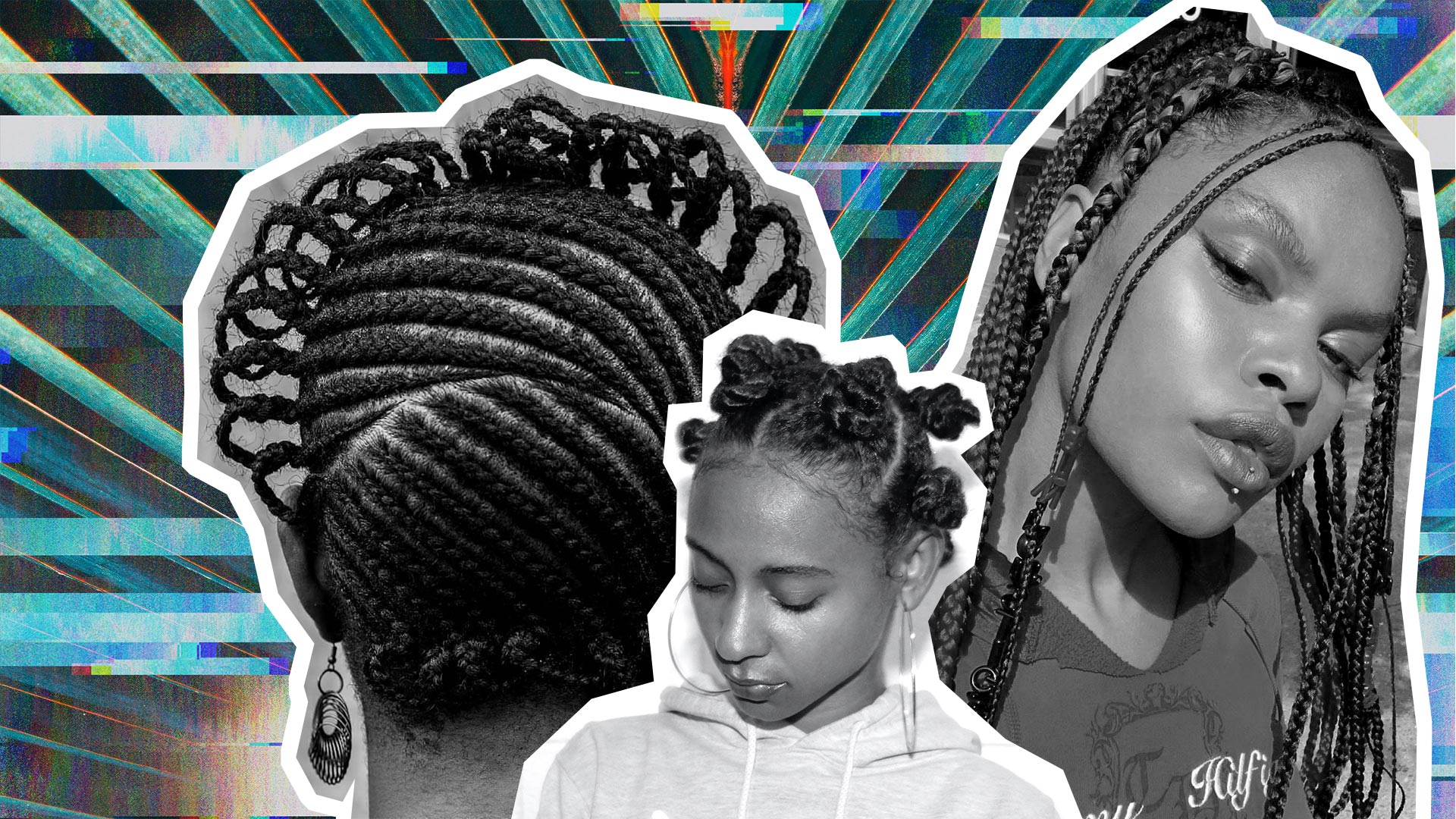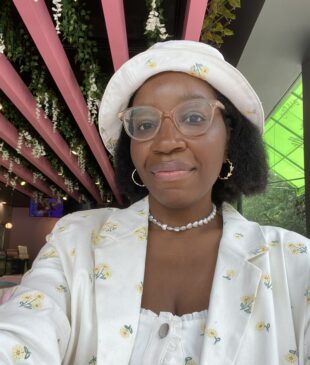If you thought the act of protesting is solely reserved for the streets, think again. For hundreds of years, hair has been used to make statements about a range of topics, from civil rights to women’s rights — but none more so than Black hair.
For Black people, hair takes on a much deeper meaning that extends beyond just being a form expression. To put it simply, it’s political. Actress Viola Davis said it best during an interview with Vanity Fair about wearing her natural hair to an awards show, “Me not wearing a wig at the Oscars in 2012 was my protest. It is a part of my voice.”
The idea of Black hair being used as “protest hair” is not a new concept. According to London-based hair expert Rachael Gibson, who runs the Hair Historian Instagram account, Black hair has been political ever since Black people were first enslaved.
“The fundamental act of enslaving people, stripping them of their basic human rights and anonymising them and erasing their culture through creating rules and regulations for how hair ‘could and should’ be worn means that any stance against that automatically feels like protest,” said Gibson. “From the antebellum practice of shaving the head to the 1786 Tignon Laws which dictated that Black women must cover their hair because white women were threatened by how elaborate it was, hair has long been integral to the fight for civil rights.
To further explore the undeniable power of Black hair as a tool of resistance, we turned to Gibson to break down five popular Black hairstyles.
The Afro:
You can’t talk about the Civil Rights Movement without mentioning the Afro. Often spotted atop the heads of The Black Panthers and civil rights activists like Angela Davis and Nina Simone, the voluminous hairstyle came to be a celebration of blackness for many during this time.
“In the 1960s, the Afro would represent a rejection of white ideals and policing of black hair; from the idea that hair should be neat and controlled to the mass marketing of hair products and Black pride,” Gibson said.
Thanks to celebrities such as Solange and Beyoncé, decades later the Afro is still just as popular and radical as ever. Who could forget all the criticism Beyoncé faced when she dressed her dancers in Black Panthers-inspired berets and Afros to perform her hit Formation during the 2016 Super Bowl Half-time Performance?
The Buzzcut:
Though often associated with the punk aesthetic, the buzzcut has always been a hairstyle popular among Black people.
“In Black culture specifically, it’s interesting as hair is culturally and symbolically very important and closely linked to spirituality and religion. Enslaved people also often had their heads shaved to humiliate/punish/anonymise. So, it’s complicated,” Gibson said. “However it’s undeniable that a shaved head on a woman is always a statement and a finger up to the idea that long hair equals femininity.”
Often rocked by ‘70s fashion models like Grace Jones and Pat Evans, the style was heavily embraced by black models who were tired of conforming to white beauty standards. In an interview with Ben Arogundade, author of Black Beauty, Evans shared that she shaved off her hair as protest, after being pressured to have long hair by the modeling industry.
The Dreadlock:
When many people think about dreadlocks, it’s not uncommon for them to associate the hairstyle with Jamaican culture.
According to Gibson, while musician Bob Marley obviously played a huge part in popularizing the style when he rose to prominence in the ‘70s, the style’s Jamaican ties actually run much deeper.
“In the 1940s and 50s when Jamaica was fighting for full independence from British rule, former enslaved people wore their hair in locs to show their rejection of the European diktats enforced by Spanish and British colonial rules,” she said. “Locs are also associated with the Rastafari religion, which started in Jamaica in the 1930s and gained popularity throughout the 1950s onwards. Locs comply with Nazarite Vow, which (in short) implies that you shouldn’t cut your hair and that hair symbolizes strength.”
Today, dreadlocks have become a favorite among Black celebrities such as Chloe + Halle, Lil Wayne, Whoopi Goldberg, Ava Duvernay and The Weeknd. While very popular, the locs are easily considered the most scrutinized Black hairstyle.
“There’s a misconstrued idea that locs are dirty or smell bad because they don’t fit the white vision of what ‘clean’ hair looks like: i.e. shiny/bouncy/run your hands through it,” Gibson said.
It’s this same thinking that led to actress Zendaya being criticized for smelling like “patchouli oil” when she wore faux locs to the Oscars in 2015.
Even the name alone for the hairstyle carries a negative connotation. According to Gibson, “the term ‘dreadlocks’ is widely accepted to have derived from slave owners. Having brought enslaved people over from Africa in horrendous conditions, slave owners referred to the loced hair as ‘dreadful.’”
The Box Braids:
While box braids have now become a staple part of mainstream culture, the style dates back thousands of years ago.
According to Gibson, “box braids have around about as long as people have – take a look at the Mbalantu women of Namibia.” She added that the hairstyle was often linked to status, given the “time, money, and effort” taken to create the style.
It was thanks to ‘90s female artists on the small screen and big screen that box braids really found its place in mainstream pop culture. You might recall Janet Jackson’s famous box braids from the 1993 film Poetic Justice?
Or how about Brandy’s braids from her debut single, “I Wanna Be Down” or really any episode of her popular sitcom Moesha?
Nowadays, it’s not uncommon to see celebrities such as Tia Mowry, Ryan Destiny or Gabrielle Union sporting a head full of braids.
The hairstyle has even found its way to the streets of recent Black Lives Matter protests where black women have been seen sporting variations of box braids while out marching. Activist Livia Rose Johnson even mentioned to Vogue, in an interview, that her braids were part of her “warrior outfit.”
Gibson views the use of the hairstyle during such a historic time in history as a way for Black people to connect to their roots and the wider community. “Given the incessant policing of black hair and the relatively recent relaxing of some discriminatory laws regarding the wearing of braids, it feels like a real positive statement to choose a hairstyle that is so definitely Black and proud,” she said.
The Cornrow:
Though often appropriated by non-black individuals such as the Kardashians, cornrows are more than just a trend. The style has deep roots in the Black community, in part earning its name during slavery.
“The most widely accepted reason for the name ‘cornrow’ is that neat rows of braids resembling lines of corn planted in the ground. In the UK and Caribbean, we sometimes see canerowing too, which reflects the sugarcane crops harvested by enslaved people,” said Gibson. “However, in the Yoruba language plaited hair (irun didi) with different patterns and styles of braids have entirely different names, which often reflect what the finished look resembles – with no links or connotations with slavery.”
Gibson adds that besides being a cultural, social activity for Black people, cornrowing hair was also a great marker for social or marital status, as well as a possible tool of resistance for enslaved people.
“There’s a lot of stories around enslaved people using braiding patterns to indicate routes to (the start of a journey to) safety – the number of roads to follow or cross directions to follow. Given that they wouldn’t have access to things like pens and paper, and that their hairstyles would not be questioned by anyone, it was an incredibly clever way to pass messages on,” she said. “I have never been able to find anything definitively confirming these stories in my textbooks on the histories of black hair, but it is so widely reported and braiding has always historically been used for messaging, that it seems highly likely to me. I don’t think it’s as literal as ‘a map of some roads on the back of a head’, but more symbolic coding to inform people to cross a river or head north.”








